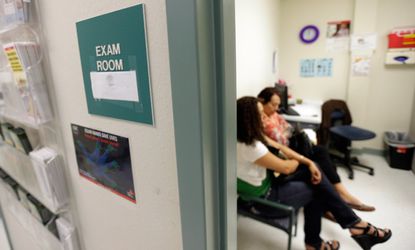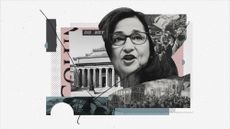Why ObamaCare will make us rethink ERs
And that's not such a bad thing


One of the cost-saving theories behind the Affordable Care Act (or ObamaCare) is that when uninsured people get health insurance, they will stop using the emergency room for routine health issues and instead visit their regular doctor. This makes some sense: The ER is typically an unpleasant place with long waits, uncomfortable seats, bad TV, and sometimes disturbingly sick people around you. Doctor's offices tend to have magazines, couches, and, frequently, fish tanks. Who in their right mind would pick the ER?
A new study in Science dumps a big cup of cold water on that theory. Harvard researchers examined the data from an Oregon health insurance experiment and found that when people got Medicaid coverage, they actually went to the emergency room more. About 40 percent more: 1.43 ER visits over the experiment's 18 months versus 1.02 visits for people who didn't get Medicaid. Statistically, that's a pretty hefty jump in ER trips.
This is probably terrible news for America's overall medical costs — emergency rooms are an inefficient and expensive way to provide health care, and ObamaCare is expected to increase the Medicaid rolls by more than 10 million. Millions more will buy health insurance for the first time through HealthCare.gov and other ObamaCare health care markets. And there's no reason to believe that new Medicaid recipients throughout the country won't act similarly to the Oregon group.
Subscribe to The Week
Escape your echo chamber. Get the facts behind the news, plus analysis from multiple perspectives.

Sign up for The Week's Free Newsletters
From our morning news briefing to a weekly Good News Newsletter, get the best of The Week delivered directly to your inbox.
From our morning news briefing to a weekly Good News Newsletter, get the best of The Week delivered directly to your inbox.
The Oregon Health Insurance Experiment (OHIE) is the kind of randomized research model health researchers would create if it weren't so casually cruel. Oregon, faced with a limited amount of money to expand Medicaid coverage in 2008, decided to hand out the available slots via lottery. That means for 18 months, researchers had a large control group of low-income Oregonians and a randomly chosen sub-group that suddenly got subsidized health care. So the Harvard study is probably a pretty accurate prediction of what we should expect in the next two years, as ObamaCare kicks in fully.
But is that necessarily such a bad thing for patients?
National medical costs aren't the only way to judge health care policy, of course, nor are they the most helpful metric for patients. And in many ways, the Harvard findings aren't really all that surprising. A previous OHIE analysis found that the Medicaid recipients also increased their visits to their primary care doctor and their use of prescription drugs.
"Improved access will lead to, well, increased access," says Aaron Carroll at The Incidental Economist. And "until someone proves to me that the increased ED [emergency department] use was unnecessary, I don't know why anyone would assume it's a bad thing."
Sign up for Today's Best Articles in your inbox
A free daily email with the biggest news stories of the day – and the best features from TheWeek.com
It also shouldn't be surprising that people visit the emergency room for more than just emergencies. ERs may be expensive and uncomfortable, but they are open 24 hours, you don't need an appointment, you find them in every city, and — it is worth emphasizing — doctors, insurance companies, and late-night nurse services often recommend you to go to the ER for quick, non-emergency medical care. (The Rand Corporation recently put out a detailed report on the evolving roles of ERs.)
So if hordes of newly insured people start flooding America's emergency rooms, there is a way of dealing with that: Create alternatives for non-emergency services. As Slate's Ray Fisman writes:
Thankfully, the problem of providing too much health care through emergency rooms is already well-appreciated by the medical community, and many health care entrepreneurs are already experimenting with ways of caring for patients more efficiently and at lower cost (to the patient and the system): Whether through a neighborhood walk-in clinic, an urgent care setting, or a doctor's office. Better still, we could aspire to provide preventive care with an eye toward individuals' longer-term best health interests, hopefully keeping more cases out of the ER and hospital inpatient wards in the future. [Slate]
If people are already inclined to go to the ER, why not change how emergency rooms operate? Earlier in his article, Fisman notes that at the hospital where his wife works as a primary care doctor, New York's Bellevue Hospital, "the ER is set up to handle urgent, non-emergency cases, and has a fast-track to route them to appropriate care."
Urgent care clinics are a great way of handing smaller, non-emergency health problems — your deep cut, sprained wrist, or minor burn — at lower costs. We should put them where people go for health care. If we can stick a Taco Bell, KFC, and Pizza Hut in the same small strip-mall storefront, why can't we put a walk-in clinic inside our emergency rooms?
Create an account with the same email registered to your subscription to unlock access.
Peter has worked as a news and culture writer and editor at The Week since the site's launch in 2008. He covers politics, world affairs, religion and cultural currents. His journalism career began as a copy editor at a financial newswire and has included editorial positions at The New York Times Magazine, Facts on File, and Oregon State University.
-
 Cicada-geddon: the fungus that controls insects like 'zombies'
Cicada-geddon: the fungus that controls insects like 'zombies'Under The Radar Expert says bugs will develop 'hypersexualisation' despite their genitals falling off
By Chas Newkey-Burden, The Week UK Published
-
 'Voters know Biden and Trump all too well'
'Voters know Biden and Trump all too well'Instant Opinion Opinion, comment and editorials of the day
By Harold Maass, The Week US Published
-
 Is the Gaza war tearing US university campuses apart?
Is the Gaza war tearing US university campuses apart?Today's Big Question Protests at Columbia University, other institutions, pit free speech against student safety
By Joel Mathis, The Week US Published